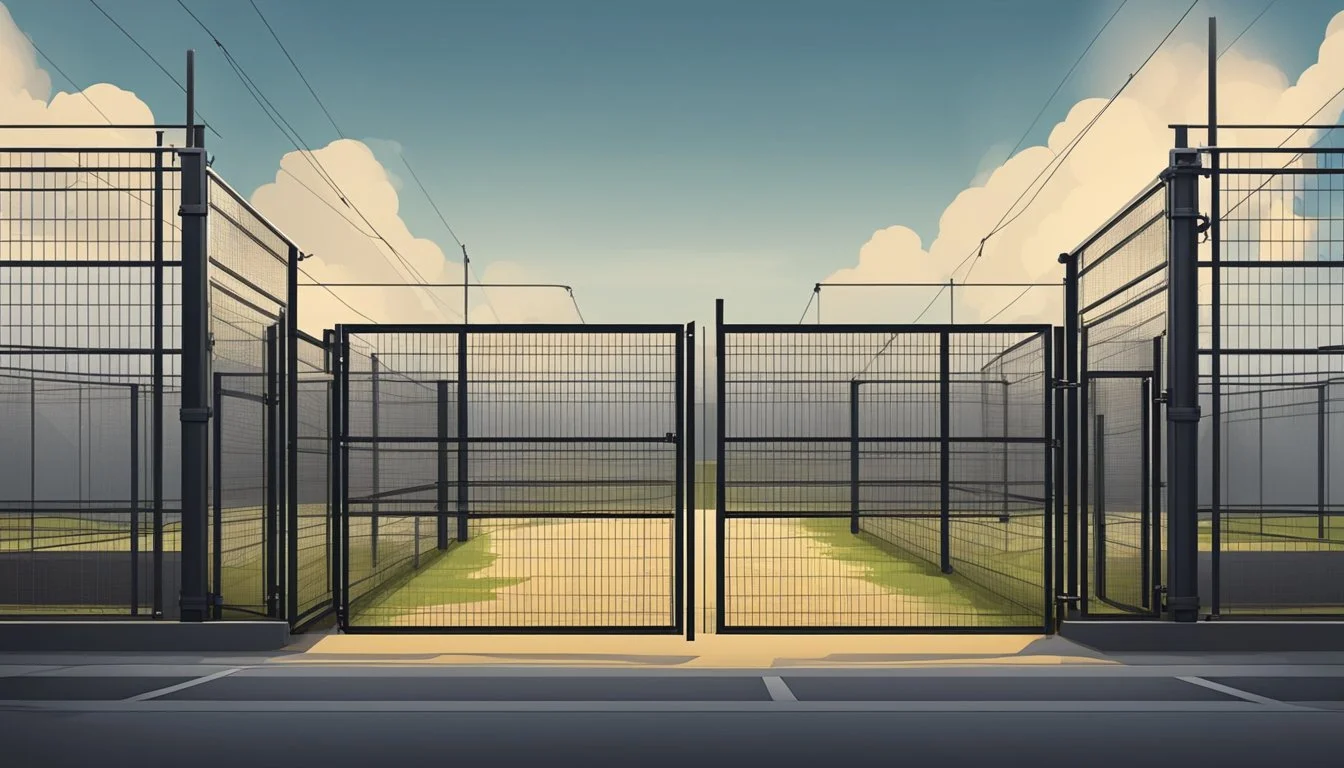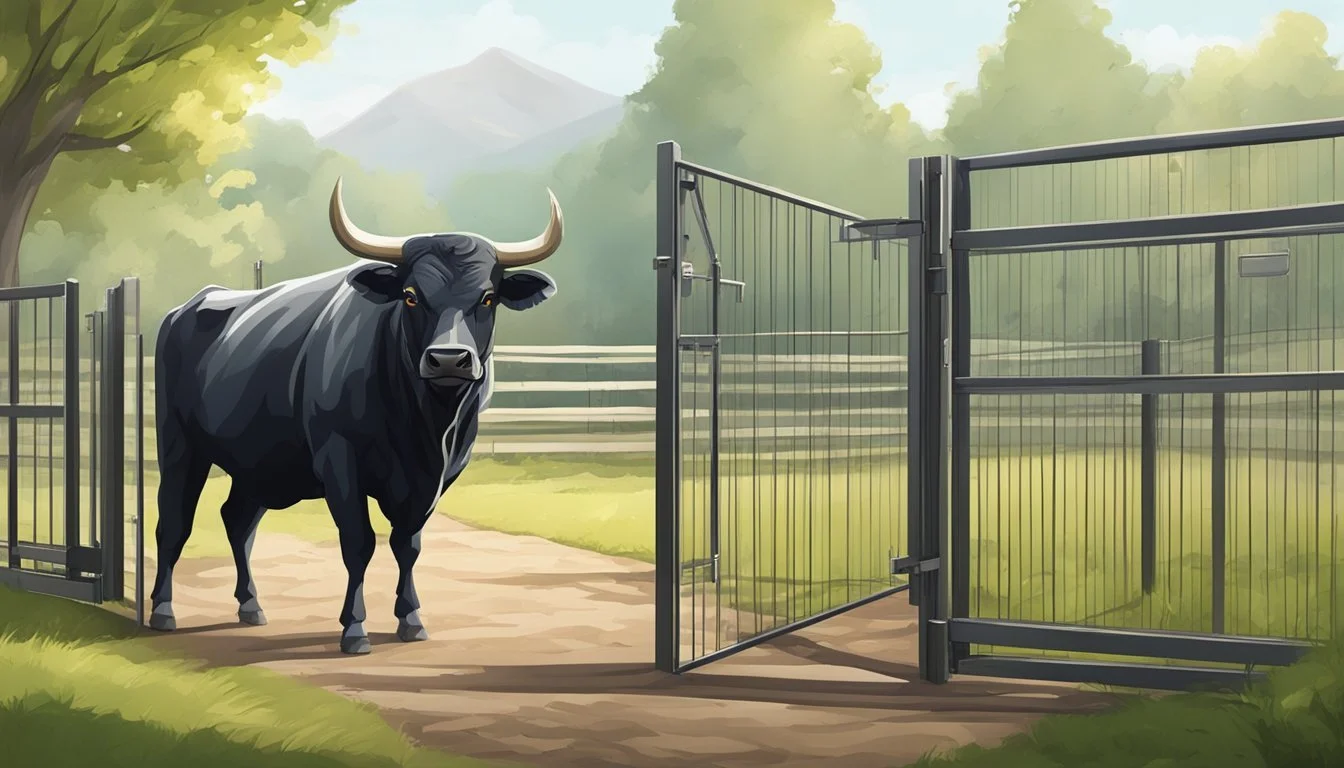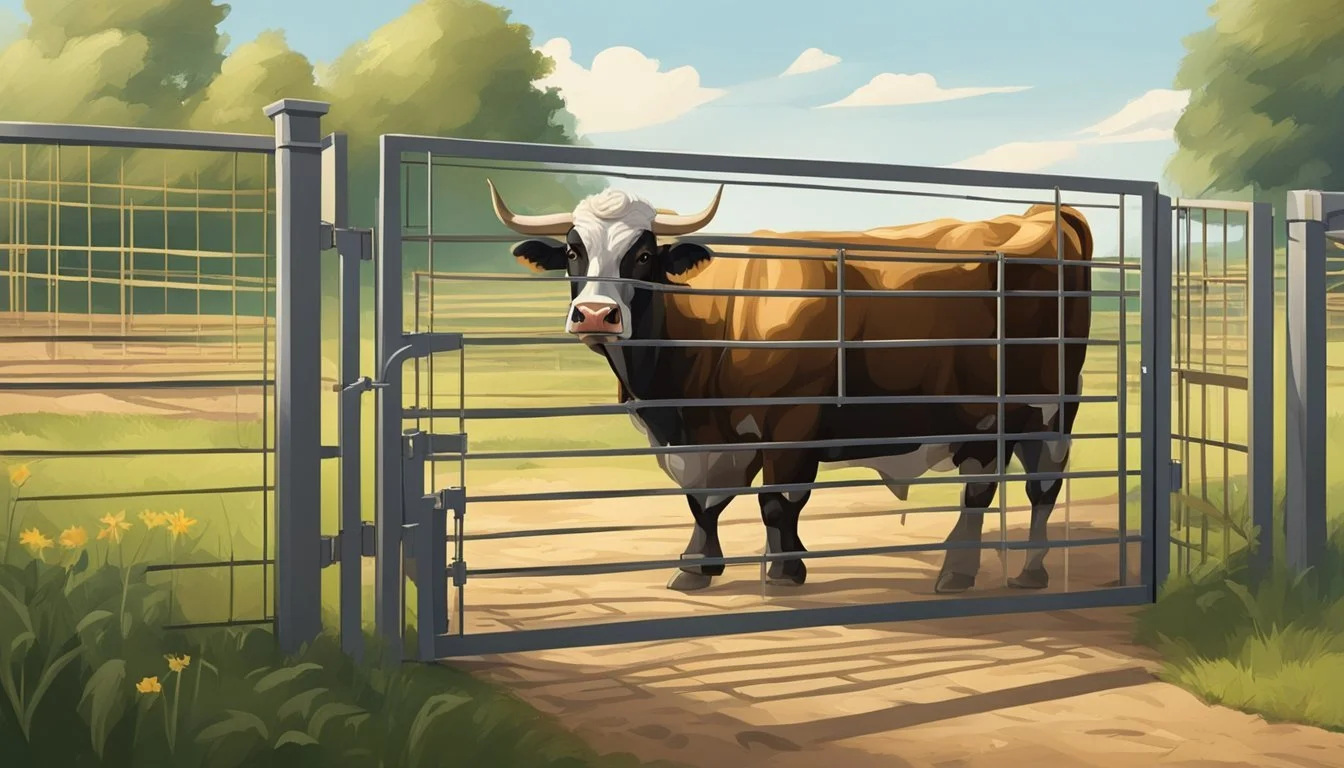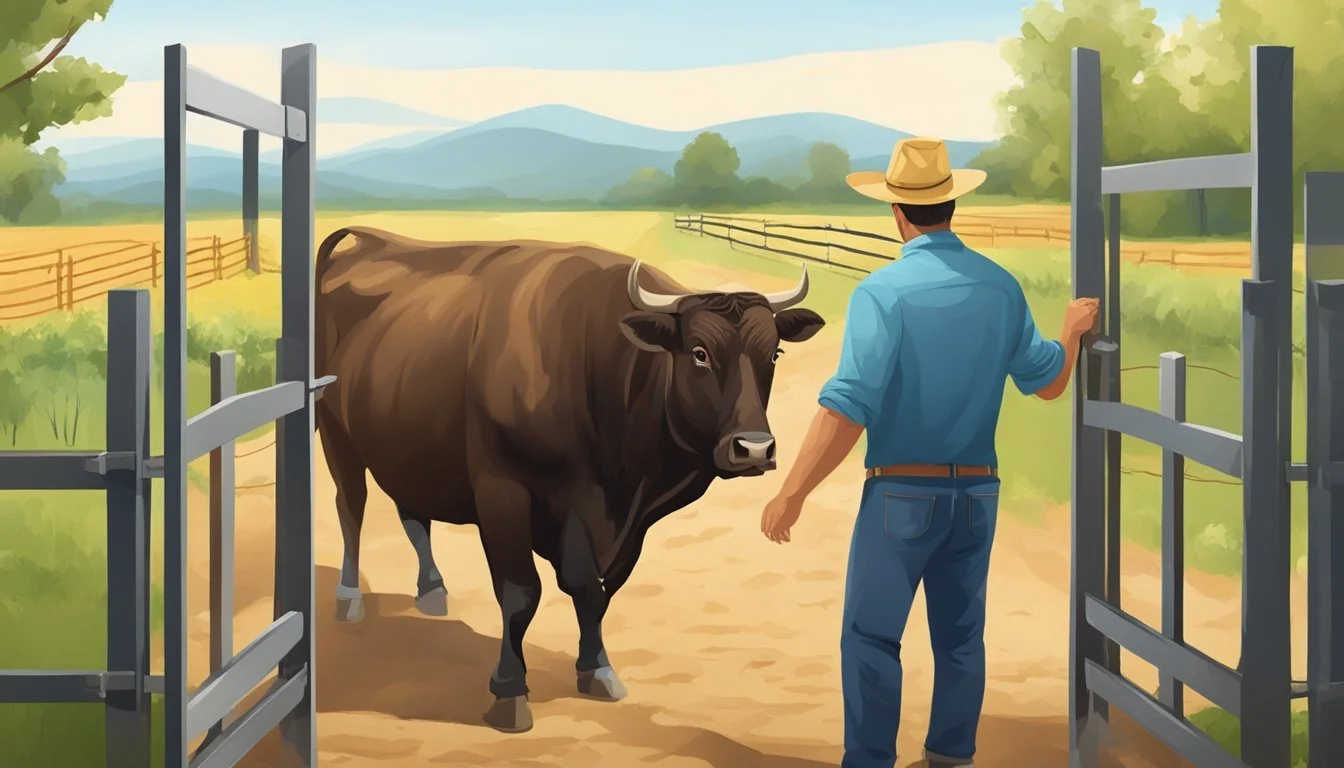How do I Handle a Bull Safely on My Farm?
Essential Tips for Farmers
Handling bulls on a farm requires a keen understanding of both animal behavior and farm safety protocols to prevent injuries. Bulls are recognized as one of the farm's most formidable animals due to their size, strength, and unpredictability. Farmers must approach the task of handling these large livestock with confidence and caution; establishing a calm and clear presence can significantly reduce the risk of triggering a bull's fight or flight response.
Effective communication with bulls involves more than just verbal cues; it necessitates an awareness of their space and movements. Before entering an enclosure with a bull, it's critical to have an escape route planned. Ensuring that the bull is aware of a person's presence without startling it is also a crucial step, as surprise can lead to dangerous reactions.
Adopting appropriate safety measures and employing tools designed for bull handling can greatly enhance control over the animal. The use of a nose ring, when handled by an experienced livestock veterinarian, can provide farmers with the necessary leverage. Choosing the right handling equipment and understanding the behavioral cues of bulls are essential components in executing safe practices on the farm.
Understanding Bull Behavior
To handle bulls safely on a farm, one must understand their behavior, which hinges on recognizing body language and signs of aggression, and understanding the instinctive fight or flight response.
Interpreting Body Language
Bulls communicate much about their mood and intentions through body language. A relaxed bull typically has a calm demeanor, with its head down and slow, measured movements. Ears pointing forward can indicate curiosity, while ears pinned back may signal irritation or anger. Observing these nuances can inform a handler about a bull's state of mind.
Recognizing Signs of Aggression
Signs of aggression in bulls should never be overlooked as they can indicate a potential for danger. A bull might exhibit aggressive behaviors like pawing at the ground, snorting, or shaking its head. These behaviors suggest that a bull feels threatened and may be prepared to attack if provoked.
Understanding the Fight or Flight Response
As prey species, bulls have an inherent fight or flight response to perceived threats. Their flight zone—the area surrounding them which, when encroached upon, triggers a need to flee or fight—varies between individuals and is influenced by their level of domestication and past human interactions. Farmers must recognize the extent of a bull's flight zone to avoid inadvertently triggering a dangerous response.
Cattle Handling Basics
When it comes to handling cattle, farm safety and animal welfare are paramount. A safe environment and low-stress techniques are essential to manage livestock effectively.
Establishing a Safe Environment
Creating a safe handling area is crucial for both the handler and the cattle. One must consider the placement of chutes and crowd pens to minimize shadows and startling contrasts, as cattle respond to these with apprehension. For example, solid sides on chutes can reduce shadows. Adequate lighting and the reduction of loud or sudden noises will maintain a calm environment and foster a sense of security among the cattle. Situational awareness is also vital; handlers should always be conscious of their surroundings and prepared to respond to the cattle's behavior.
Low-Stress Handling Techniques
Low-stress cattle handling techniques prioritize the cattle's instinctive behaviors and natural herd dynamics. Handlers should encourage docile behavior through calm and deliberate movements, avoiding fast motions that might trigger the cattle's fight or flight response. Give clear and unthreatening cues to guide cattle. For instance, understanding cattle's point of balance and flight zone allows handlers to move them efficiently without causing distress. Methods that incorporate these principles ensure that livestock can be managed in a safe manner and are key to reducing the risk of injuries. They contribute to the overall efficiency of farm operations by promoting the welfare and productivity of the herd. Engaging livestock with a considered and informed approach is conducive to handling bulls safely and applies to all cattle handling scenarios.
Farm Infrastructure for Safety
Creating a secure environment for handling bulls involves careful planning and construction of farm infrastructure. Robust fences and gates, well-maintained working facilities, and the correct use of handling equipment form the cornerstone of on-farm safety protocols.
Designing Fences and Gates
Strong, durable fencing is essential when raising cattle, especially for containing bulls. It is advised to use materials that can withstand the strength of a bull, such as heavy-duty steel posts and reinforced mesh. Gates should be of similar strength and fitted with secure latching mechanisms to prevent unintended openings.
Fences: Minimum 5 feet in height, using reinforced materials.
Gates: Equipped with heavy-duty hinges and latches.
Building and Maintaining Working Facilities
A well-designed working facility includes a sturdy corral system, which safely guides cattle toward the squeeze chute. Regular maintenance ensures that facilities remain safe and functional. Inspection for wear and rust can prevent accidents and keep both livestock and handlers secure.
Corral: Should include a series of pens leading to the handling area.
Chute: A squeeze chute secures the animal and should be maintained to work smoothly.
Safe Use of Handling Equipment
The use of equipment like bud boxes can contribute to low-stress cattle handling. Handlers should position themselves safely, avoiding blind spots and ensuring they have an escape route. Implementing and adhering to safe operational procedures with all handling equipment is crucial for safety.
Bud Box: Assists with directing cattle into a chute without causing distress.
Safety Protocol: Training on equipment use to minimize risk.
Safety Protocols and Procedures
When handling bulls, a farmer's top priorities should include establishing strict safety measures, devising a reliable escape plan, and performing regular safety evaluations. These efforts are vital as bulls are among the most dangerous animals on a farm.
Developing Strict Safety Practices
Strict safety practices are essential in managing bulls to minimize the risk of injury. Farmers should provide clear and unthreatening commands to the animals to maintain a stress-free environment. They are advised to familiarize themselves with the behavior of bulls and to always remain vigilant.
Training: All farm workers must be trained in understanding bull behavior and signs of agitation.
Personal Protective Equipment (PPE): Use appropriate PPE such as durable boots and gloves.
Creating an Effective Escape Plan
Having an effective escape plan in place is critical when working with bulls. Before entering an enclosure with a bull, one should know the quickest route to safety.
Escape Routes: Clearly mark multiple escape routes in all handling areas.
Practice Drills: Conduct regular drills so all farm workers are familiar with escaping quickly and safely in case of an emergency.
Implementing Routine Safety Checks
Routine safety checks are a cornerstone of farm safety, ensuring that both handlers and bulls remain safe. This includes inspecting fences, gates, and handling equipment for integrity and functionality.
Equipment Checklist:
Inspect fences and gates for damage.
Ensure the squeeze chute and other handling equipment are in good working order.
Environment Assessment: Regularly assess the environment to reduce factors that could startle bulls, such as shadows or loud noises, to avoid initiating a fight or flight response.
Managing Breeding Safely
In ensuring farm safety, managing bull breeding involves careful pairing and secure handling practices. These steps reduce risks for both the animals and farm personnel.
Pairing the Bull for Breeding
When pairing bulls for breeding, it's essential to evaluate both the physical compatibility and the genetic benefit they bring to the offspring, or calves. Bulls should be matched with cows based on traits that will enhance the herd's overall performance. Ensure the breeding area is secure and that the bull and cows have ample space to interact safely. Observing bull behavior closely during the pairing can prevent aggressive encounters.
Handling Bulls during Artificial Insemination
During artificial insemination, handlers must maintain a calm and controlled environment for the bulls. Bulls need to be restrained appropriately to allow safe collection of semen. This typically involves a secure pen or chute designed to limit movement without causing stress to the bull. Proper training for technicians performing the procedure is critical in minimizing potential danger and ensuring the bulls are handled with expertise.
Bull Management and Care
Successful bull management and care are critical for maintaining farm safety and ensuring the wellbeing of livestock. It requires diligent planning in two key areas: nutrition and health routines, and vaccinations and veterinary visits. Each aspect plays a vital role in the development and maintenance of healthy, manageable bulls.
Nutrition and Health Routines
Bulls require a balanced diet rich in nutrients to support their large body size and breeding capabilities. They should have access to:
High-quality forage: which can be assessed and adjusted based on seasonal availability.
Supplements: including minerals and vitamins to prevent deficiencies.
Fresh water: ensuring it is available at all times to prevent dehydration.
Health routines must include regular check-ups and breeding soundness exams before the breeding season. It is also crucial to monitor bulls for any signs of lameness, injury, or stress, which can greatly affect their performance and behavior.
Vaccinations and Veterinary Visits
Vaccinations are a key preventative measure to protect bulls from common diseases. A typical vaccination program may include but is not limited to:
Clostridial diseases: a series of shots that often start when the bull is a calf.
Respiratory diseases: to fight against viruses that can compromise the bull's health and breeding efficacy.
Regular veterinary visits are important for maintaining the health and fertility of bulls. They provide an opportunity for the vet to administer necessary vaccinations and perform health assessments. During these visits, veterinarians might also address any specific concerns related to raising cattle, such as reproductive issues or abnormal behavior that could indicate underlying health problems. Moreover, establishing a good relationship with a veterinarian makes it easier to manage emergencies or seek advice on cattle handling techniques tailored to the specific needs of the farm's bulls.
Mitigating Risks In Specific Scenarios
Handling bulls necessitates an awareness of the inherent risks and the implementation of specific strategies to mitigate them, especially during interactions with visitors or when separating bulls from the herd for farm tasks.
Interacting with Bulls in the Presence of Visitors
When visitors are present on the farm, it is crucial to ensure their safety around bulls. Firstly, one should establish clear boundaries for visitors, excluding them from direct contact with the bulls to prevent accidents. Adequate signage and physical barriers should be in place. Secondly, visitors, particularly children, must be accompanied by an experienced farmhand to ensure they remain at a safe distance, as bulls can experience stress in unfamiliar situations, leading to unpredictable behavior.
Separating Bulls from the Herd for Farm Tasks
Separating a bull from the herd requires a calm and methodical approach to avoid stress to the animal, which can increase the risk of accidents. Utilize robust handling facilities, such as a well-maintained crush and secure gates, to ensure the safety of both the handlers and the bull. Only personnel with experience in handling bulls should perform this task to minimize the risk of injuries. The bull's vision and flight zones should be understood and respected throughout the process to maintain a calm environment.
Legal and Statistical Context
The management of large livestock on farms is bound by regulatory environments and documented through data on incidents and injuries. This context provides a framework for understanding both the legal parameters around handling bulls and the statistical reality of cattle-related fatalities.
Understanding Livestock-Related Regulations
In the United States, livestock management, including that of bulls, falls under the oversight of various regulatory bodies. It is essential for farmers to be familiar with guidelines set forth by the U.S. Department of Agriculture (USDA), which might include specifics on biosecurity risk measures to prevent disease outbreaks. Compliance with local and state regulations that pertain to livestock is also mandatory. Guidelines can encompass how to handle bulls properly to ensure the safety of both the handler and the animal.
Reviewing Cattle-Related Fatality Data
Statistical analysis provides a sobering perspective on the risks involved in handling cattle. According to the U.S. Department of Labor Census of Fatal Occupational Injuries, handling large livestock can be hazardous, with fatalities occurring under particular circumstances. The surveillance of Occupational Injuries and Illnesses Databases monitors these incidents, offering essential insights. For instance, numbers compiled by the University of Wisconsin have indicated that bulls have been responsible for at least 19 deaths in the state since the 2000s. These statistics underscore the importance of adhering to safety protocols when dealing with bulls.
Improving Bull Handling Skills and Knowledge
Enhancing one's proficiency in bull handling is a multifaceted venture, encompassing continual professional development and the adoption of innovative cattle management strategies. Mastering these elements is crucial for ensuring safety and fostering a low-stress environment for both handlers and animals.
Professional Development and Training
Professional development plays a pivotal role in fostering agricultural competencies. Those responsible for handling livestock should seek out educational opportunities to stay abreast of the latest best practices. Courses and workshops by agricultural institutions are vital resources for this, as they provide handlers with training on how to interpret animal behavior, reducing the likelihood of accidents. Attending local or online cattle handling seminars can equip farmworkers with practical skills and knowledge, enhancing their ability to maneuver bulls safely.
Adopting Innovations in Cattle Handling
In an industry where efficiency and safety are paramount, the integration of innovations in cattle handling equipment and techniques is essential. Upgrades such as the incorporation of specialized handling equipment can minimize the need for direct contact—this approach not only improves safety but also streamlines the entire handling process. By integrating low-stress handling techniques, farms can maintain a calm environment that is conducive to both cattle welfare and handler safety.
Exploring and implementing these innovations helps manage bulls more effectively and can lead to a safer, more productive farm operation.
Special Considerations for Different Types of Bulls
When handling bulls on a farm, it's crucial to understand that different types of bulls may require distinct handling approaches. Dairy bulls, beef bulls, and varying dominance levels among these animals can influence their behavior and the strategies needed for safe management.
Handling Dairy Bulls
Dairy bulls tend to be more unpredictable and may display more aggressive behavior, necessitating heightened caution. When working with dairy bulls, safe handling techniques include always having an escape route and using barriers to maintain a safe distance. An emphasis on low-stress handling is essential, as sudden movements or loud noises can trigger a bull's fight or flight response. It's important to remain calm and avoid direct eye contact that could be interpreted as a challenge. For more details on handling methods, visit Handling bulls safely.
Handling Beef Bulls
Beef bulls usually possess a more docile temperament compared to dairy bulls but still require respect and careful handling. They are often larger and can become aggressive, especially during the breeding season. Handlers should use clear cues and consistent routines to communicate with beef bulls, reinforcing cooperative behavior. Beef bulls may respond well to controlled environments where they can be managed with less direct contact—potentially through the use of chutes and pens designed for safe interaction. Learn about the necessary facilities for beef bull management at The Rules Of Yearling Bull Management.
Handling Non-Dominant Versus Dominant Bulls
Dominant bulls present a higher risk due to their assertive nature and desire to maintain hierarchy within the herd. Handling these bulls requires a handler to be particularly aware of the bull's body language and to employ tactics that do not challenge their dominance. By contrast, non-dominant bulls can be more cooperative, but handlers should still exercise caution, as these animals can become assertive if they feel threatened. Regardless of the dominance level, all bulls should be handled with a focus on safety, using tools such as a bull staff for more control if necessary. Techniques for managing bull aggression and behavior can be referenced at Why Are Bulls So Aggressive?.
Emergency Response and First Aid
When handling bulls, farmers must be prepared for the possibility of attacks or injuries. It's crucial to respond effectively to such accidents and to provide immediate care to mitigate further harm.
Responding to Bull Attacks or Injuries
In the event of a bull attack, the first priority is to ensure personal safety. If they find themselves at risk of being run over, individuals must use their pre-planned escape route to quickly distance themselves from the bull. Once safe, they should assess the situation: if someone else is injured, one should calmly, yet swiftly, check the extent of the injuries from a safe position. At this stage, the main goal is to stabilize the situation without exacerbating the risk.
Administering Immediate Care After Accidents
If an accident results in injuries, immediate care is essential while waiting for professional medical assistance. They should clearly communicate the nature of the incident when calling for help, relaying the severity of injuries and the exact location for a quicker response. In the meantime, basic first aid practices, such as controlling bleeding with clean cloths and keeping the injured person calm and stationary, can be lifesaving. Knowledge of proper first aid techniques is paramount, and it's beneficial to be familiar with resources such as the Emergency Response Plan for Livestock Producers from Penn State Extension or the Farming Emergency Response First Aid Tips for guidance on managing such critical situations.
Creating a Culture of Safety on the Farm
Creating a culture of safety on a farm involves several key steps to ensure all operations, including the handling of bulls, are conducted in a safe manner. It's imperative to establish strict safety practices that everyone on the farm adheres to, from adults to children.
Firstly, farmers should prioritize education and training for all farmhands. This includes specific training on how to handle large livestock, because bulls require experienced and cautious treatment to prevent accidents. Safety equipment is also essential, such as using sturdy pens and having quick exit routes when working with bulls.
Secondly, on farms where children are present, it's crucial to instill a sense of responsibility and caution around all farm activities. Children should be trained on safety protocols and kept away from bulls and other high-risk tasks unless closely supervised by an experienced adult.
Routine safety audits and risk assessments can reveal potential hazards before they lead to accidents. Farms utilizing these practices can pre-emptively address issues, maintaining a safe environment for all.
Lastly, farmers must lead by example, with everyone on the farm committed to practicing safety at all times. Reinforcing these practices daily helps to create a mindset where safety is always at the forefront, leading to a more secure farm for employees, family members, and the animals themselves.







